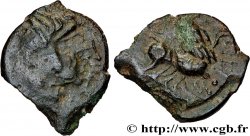bga_692628 - GALLIA - BITURIGES CUBI (Area of Bourges) Potin au bucrane et au cheval
100.00 €(Approx. 117.00$ | 86.00£)
Quantity
Add to your cart

Type : Potin au bucrane et au cheval
Date: Ier siècle avant J.-C.
Metal : potin
Diameter : 18 mm
Orientation dies : 3 h.
Weight : 2,01 g.
Rarity : R3
Coments on the condition:
Monnaie ayant conservée de jolis détails au revers, et une très belle patine sombre
Obverse
Obverse legend : ANÉPIGRAPHE.
Obverse description : Bucrane accosté de deux esses, une croisette entre les cornes ; un grènetis en descendant d’une corne à l’autre et bourrelet périphérique.
Reverse
Reverse legend : ANÉPIGRAPHE.
Reverse description : Cavalier (?) à gauche ; grènetis perlé et bourrelet périphérique.
Commentary
Monnaie cassée. Ce potin est très rare ; seulement connu par un exemplaire au musée de Zurich et de très rares en collections privées, c’est la seconde fois que nous le proposons à la vente après le bga_364110 de CELTIC 9 et nous n’en avons jamais vu passer d’autre en catalogues !
Le prototype du droit est clairement le potin des Rèmes au bucrane, lui-même inspiré du rare sesterce de Caius Antius Restio frappé vers 45 avant J.-C. Le revers au cheval n’a rien à voir avec l’ours du potin des Rèmes.
Le cavalier supposé n’est pas visible sur le n° 275 de Zurich (lui-même repris en dessin par A. Gaumann pour son n° 176). Le n° 24.5 de H. Patat correspond à notre monnaie, mais le cavalier pourrait n’être qu’une interprétation à partir de globules qui auraient fusé entre eux....
Broken coin. This potin is very rare; only known from a example in the Zurich museum and very rare ones in private collections, this is the second time that we are offering it for sale after bga_364110 from CELTIC 9 and we have never seen another one appear in catalogs ! The prototype of the law is clearly the Remi potin on the bucrane, itself inspired by the rare sestertius of Caius Antius Restio struck around 45 BC. The reverse on the horse has nothing to do with the bear of the potin of the Remes. The supposed rider is not visible on number 275 of Zurich (itself used in drawing by A. Gaumann for his number 176). No. 24.5 by H. Patat corresponds to our coin, but the rider could only be an interpretation based on globules which would have merged between them...
Le prototype du droit est clairement le potin des Rèmes au bucrane, lui-même inspiré du rare sesterce de Caius Antius Restio frappé vers 45 avant J.-C. Le revers au cheval n’a rien à voir avec l’ours du potin des Rèmes.
Le cavalier supposé n’est pas visible sur le n° 275 de Zurich (lui-même repris en dessin par A. Gaumann pour son n° 176). Le n° 24.5 de H. Patat correspond à notre monnaie, mais le cavalier pourrait n’être qu’une interprétation à partir de globules qui auraient fusé entre eux....
Broken coin. This potin is very rare; only known from a example in the Zurich museum and very rare ones in private collections, this is the second time that we are offering it for sale after bga_364110 from CELTIC 9 and we have never seen another one appear in catalogs ! The prototype of the law is clearly the Remi potin on the bucrane, itself inspired by the rare sestertius of Caius Antius Restio struck around 45 BC. The reverse on the horse has nothing to do with the bear of the potin of the Remes. The supposed rider is not visible on number 275 of Zurich (itself used in drawing by A. Gaumann for his number 176). No. 24.5 by H. Patat corresponds to our coin, but the rider could only be an interpretation based on globules which would have merged between them...








 Report a mistake
Report a mistake Print the page
Print the page Share my selection
Share my selection Ask a question
Ask a question Consign / sell
Consign / sell
 Full data
Full data










